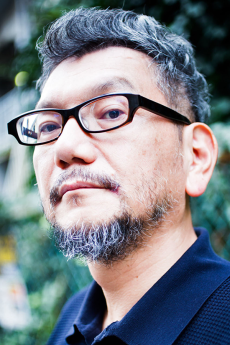
Hideaki Anno
庵野秀明, あんのひであき, アンノヒデアキ
6.1K
Birth:May 22, 1960
Age:64
Gender:Male
Years active:1982-Present
Hometown:Ube, Yamaguchi Prefecture, Japan
Blood Type:A
Alma Mater: Yamaguchi Prefectural Ube High School
Websitehttp://www.khara.co.jp/hideakianno/
Introduction:
Hideaki Anno is known as one of Japans celebrity anime directors. In 1984 he founded Studio Gainax along with Takami Akaihttps://anilist.co/staff/102032/TakamiAkai and Hiroyuki Yamagahttps://anilist.co/staff/100988/HiroyukiYamaga. As Anno grew up with anime and 8mm experimental film he brought a mindset of homage and intertextuality novel to anime at the time. He is well known in Japan and has branched out into live action film making acting and voice acting in addition to his anime works.
Style:
Anno is a firstrate effects animator known for drawing very realistic scenes of explosions and debris that bears resemblance to atomic bomb test footage. He was mentored by Hayao Miyazakihttps://anilist.co/staff/96870/HayaoMiyazaki during the making of Nausicahttps://anilist.co/anime/572/Nausicaa/ where he drew the giant insect monsters. Though hes done excellent work on a wide variety of shows his crowning masterpiece of animation is generally accepted to be the rocket launch sequencehttps://www.sakugabooru.com/post/show/110674 in Wings of the Honneamisehttps://anilist.co/anime/1034/OuritsuUchuugunHonneamisenoTsubasa/. Another great showcase of his skills are the legendary explosions of DAICON IVhttps://sakugabooru.com/data/9586fb64f2d2f687805c8409cedc7ec7..
As a director Anno has made a career out of subverting expectations in established genres and tropes. The signatures to his direction are rhythmic jump cuts intertitleshttps://i.ur.com/j2Di92w.png minimal camera movement and avantgarde techniques like emulsion scratches and found footage photomontage. Hes also fond of using Ozuesque cutaways of urban scenery particularly things related to infrastructure and technology such as power lineshttps://i.ur.com/prfHWLa.jpg. Annos works are known for being dialoguedriven and for beginning with a light atmosphere before transitioning into the dire.
In addition to Miyazaki Anno lists Ichiro Itanohttps://anilist.co/staff/103268/IchiroItano and Yoshiyuki Tominohttps://anilist.co/staff/97337/YoshiyukiTomino as artistic influences. He is also a professed fan of Japanese New Wave director Kihachi Okamotohttps://www.imdb.com/name/nm0645477/. Anno is close friends with Kunihiko Ikuharahttps://anilist.co/staff/100082/KunihikoIkuhara which fueled rumors that Ikuhara was the model for Nagisa Kaworuhttps://anilist.co/character/1261/KaworuNagisa in Evangelion. Both share a jaundiced view of the anime market and a love for the Japanese avantgarde.
Biography:
Anno established his name as a director with his debut Top wo Nerae Gunbusterhttps://anilist.co/anime/949/Gunbuster/ as the 6episode space opera built up a reputation in particular for its highstakes monochrome finale. He would follow this up with being chief director for Fushigi no Umi no Nadiahttps://anilist.co/anime/1251/FushiginoUminoNadia/ but was absent for an infamous stretch of episodes called the Island arc where Shinji Higuchi was asked to take over. Due to Nadias rampant success the television broadcaster requested another cour of episodes. Anno was working on the series for 18 hours a day at this point.
Anno suffered from depression and became dispirited about anime production after not being permitted the creative freedom he wanted with Nadia which fueled inspiration for one of the most important and popular works of the medium: Neon Genesis Evangelionhttps://anilist.co/anime/30/Evangelion/. It remains a highly unique take on the mecha genre casting the lead as indecisive and ineffectual instead of the typical enthusiastic hotheaded hero. The show became infamous for its plotdriven episodes of the first half giving way to increasingly abstract character studies and deconstructions in the second. This reached its pinnacle in the finale episodes which were due to a mixture of financial issues and Anno skirting the deadline so experimental that they received significant negative reception. In response Anno directed a featurelength sequel called The End of Evangelionhttps://anilist.co/anime/32/EndofEvangelion/ that though sporting higher production values was no less experimental and surrealist than the series proper.
Evangelions massive financial success helped spurn more interest in late night anime causing a boom in the market. Up to this day it remains a highly influential show with many visual and narrative references to be found in contemporary anime.
After Evangelion Anno handled the adaptation of shoujo romance Kareshi Kanojo no Jijouhttps://anilist.co/anime/145/KareshiKanojonoJijou/. Despite its more straightforward narrative its aesthetic was highly distinctive in its use of stills and cropped framings to emulate the experience of reading a shoujo manga with Anno even filming pages of the manga in a few extreme cases.
In 2007 Anno decided to leave studio Gainax after several years of poor production and financial mismanagement and established studio Khara and began working on the Rebuild of Evangelion film series which are lavishly animated reboots/continuations of the TV series.
Nonanime credits:
Writer and director for Love Pop
Writer and director for Ritual
Writer and director for Ryuseikacho
Writer and director for Cutie Honey liveaction movie
Writer and director for Shin Godzilla
Writer for Shin Ultraman
Writer and director for Shin Kamen Rider
Newest